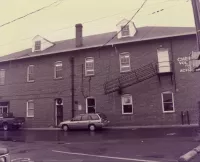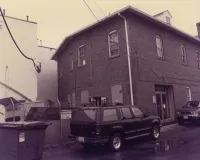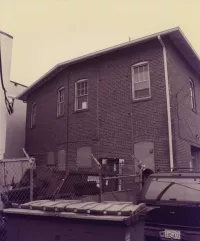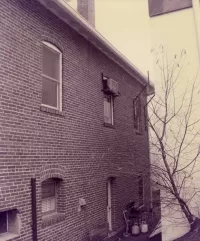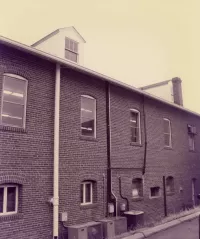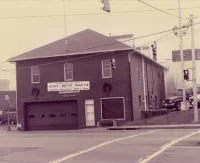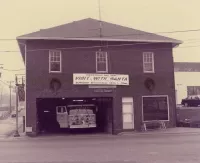Share what you know,
and discover more.
Share what you know,
and discover more.
Jul 28, 1995
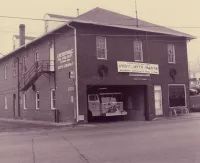
-

- Charmaine Bantugan
National Register of Historis - Cherrydale Volunteer Fire House (VDHR No. 00-82)
Statement of Significant: The Cherrydale Volunteer Fire House is historically significant for its association with the 20th century development of the community of Cherrydale, one of Arlington County's commuter subdivisions. Additionally, the building has significance as a physical reminder of 20th-century progress in firefighting technology and the establishment of firefighting as a discipline. Since its construction in 1919, the Fire House has been an important structure in community affairs, serving collectively as a fire house, movie theater, specialty shop, and community center. The first fire house to be constructed in Arlington County, the Cherrydale Fire House is the home of the Cherrydale Volunteer Fire Department, the first officially organized fire department in the county. Therefore, the Cherrydale Volunteer Fire House meets Criteria A of the National Register of Historic Places. HISTORICAL BACKGROUND ARLINGTON COUNTY AND ITS TWENTIETH CENTURY DEVELOPMENT During the years before the turn-of-the-century Arlington County maintained its rural character. Few formalized services or community provisions such as water and sewer systems enhanced the quality of life usually associated with suburban areas. Public utilities such as gas and electricity were not available to the majority of Arlington County residents until 1910. Much of the County was still rural farmland, and its residents continued to transport produce along dirt roads into the District of Columbia for distribution. The commencement of the 20th century heralded major civic, social and governmental improvements throughout the county. By the 1920s the character of the County had dramatically changed with rapid subdivision and development of suburbs such as Ballston, Cherrydale, and Barcroft. This suburban development is evidenced by the increase in the county's population, from 6,430 in 1900 to 16,040 in 1920. During the 1930s and 1940s, large numbers of houses and garden apartments were constructed, throughout the county as Arlington kept pace with the expansion of Federal activities and the demand for housing throughout the metropolitan area. The rapid expansion and enormous development activity of the Northern Virginia suburbs in the 1960s and 1970s transformed the rural, community based character of Arlington County to a predominately transient urban/suburban area. The resultant population increase and augmented traffic in the residential and commercial sections of the County have strained the cohesiveness and capacity of the County's communities as well as public services. Many of the County's civic associations and community groups have banded together to ensure that important neighborhood structures are maintained as figurative points of reference within these rapidly changing environments. Despite the overall change in the County's historic context over the last 100 years, the neighborhood buildings such as the Cherrydale Fire Station, the Barcroft Community House and the Clarendon School, retain their land use context and the communities have remained very much the same. Consequently, these structures have achieved a significance and importance in their communities as the social relationship between the buildings and their neighborhoods has gotten stronger over time. THE ESTABLISHMENT OF CHERRYDALE Cherrydale, and its surrounding area, was originally deeded by Lord Fairfax to Thomas Going in 1708. The Goings family, who bred horses, were one of the largest early landowners in Arlington County. The city of Alexandria was founded on part of the land holdings of Alexander Going. Primarily growing tobacco, the smaller farms in the area soon became infertile, causing the 18th century farmer to relocate farther west to what is now Fairfax and Loudoun Counties. It was not until the creation of Washington, D.C., in 1801, concurrent with the erection of bridges and turnpikes connecting the county with the district, that the farmers were encouraged to diversify their agricultural crops. The easy access to Washington, D.C., and Georgetown markets made Arlington County an ideal location for fruit orchards and truck farming.' Andrew Donaldson, the first known settler to this area of Arlington County that would later become Cherrydale, began farming as early as the 1780s. Despite the destruction caused by the Civil War in the 1860s, small settlements began to appear throughout Arlington County. Union troops who had camped and maneuvered in the area, remained after the war to establish farms. One of the settlements that developed was Cherrydale, bounded on the east and south by what is now I-66, on the north by Lorcom Lane and Old Dominion Drive, and on the west by North Utah Street and the H. B. Woodlawn School property. Inspired by the family- operated cherry orchard, Dorsey Donaldson, along with his son-in-law Robert Shreve, named the area Cherrydale in their 1893 application for a post office. Only a few remnants of the original cherry orchards survive today along what was Cherry Valley Road, now Quincy Street. The notion of Cherrydale as a commuter village began by the turn of the century with the extension of the Great Falls Division of the Washington and Old Dominion Railway. The commuter trains and trolleys ran on the north side of Lee Highway, providing an inexpensive, reliable form of transportation for people living in the "country" of Cherrydale. Concurrent with the expansion of the railroad, astute developers were acquiring land for real estate development. Initially development was impeded by the scandalous reputation of Arlington County as the home of unapproved pastimes, such as drinking and gambling. The developers, together with the law-abiding citizens, established the Good Citizens League. Civic pride ensued and reformer, Crandal Mackey, was elected the commonwealth's attorney. Mackey proceeded to make Arlington safe, and development prospered by the first decades of the 20th century. Despite the steady growth of the Arlington County population as a whole, Cherrydale contained only a small concentration of citizens. Nevertheless, this little community is credited with organizing Arlington County's first volunteer fire department and constructing the first Arlington County firehouse. Cherrydale boasts a number of other Arlington County firsts as well. Cherrydale founded Arlington County's first Girl Scout troop (1917), the first motion picture theater (1912), the first health care clinic (1921), and the first county-employed dentist (1920). One of the county's earliest citizens groups, the Cherrydale Citizens Association, was created in 1910. During the years between 1900 and 1930, the Cherrydale area was divided into residential lots measuring 20'x 50'. By the 1930s the built environment included one apartment building, a few multiple dwellings, and numerous single dwellings.
National Register of Historis - Cherrydale Volunteer Fire House (VDHR No. 00-82)
Statement of Significant: The Cherrydale Volunteer Fire House is historically significant for its association with the 20th century development of the community of Cherrydale, one of Arlington County's commuter subdivisions. Additionally, the building has significance as a physical reminder of 20th-century progress in firefighting technology and the establishment of firefighting as a discipline. Since its construction in 1919, the Fire House has been an important structure in community affairs, serving collectively as a fire house, movie theater, specialty shop, and community center. The first fire house to be constructed in Arlington County, the Cherrydale Fire House is the home of the Cherrydale Volunteer Fire Department, the first officially organized fire department in the county. Therefore, the Cherrydale Volunteer Fire House meets Criteria A of the National Register of Historic Places. HISTORICAL BACKGROUND ARLINGTON COUNTY AND ITS TWENTIETH CENTURY DEVELOPMENT During the years before the turn-of-the-century Arlington County maintained its rural character. Few formalized services or community provisions such as water and sewer systems enhanced the quality of life usually associated with suburban areas. Public utilities such as gas and electricity were not available to the majority of Arlington County residents until 1910. Much of the County was still rural farmland, and its residents continued to transport produce along dirt roads into the District of Columbia for distribution. The commencement of the 20th century heralded major civic, social and governmental improvements throughout the county. By the 1920s the character of the County had dramatically changed with rapid subdivision and development of suburbs such as Ballston, Cherrydale, and Barcroft. This suburban development is evidenced by the increase in the county's population, from 6,430 in 1900 to 16,040 in 1920. During the 1930s and 1940s, large numbers of houses and garden apartments were constructed, throughout the county as Arlington kept pace with the expansion of Federal activities and the demand for housing throughout the metropolitan area. The rapid expansion and enormous development activity of the Northern Virginia suburbs in the 1960s and 1970s transformed the rural, community based character of Arlington County to a predominately transient urban/suburban area. The resultant population increase and augmented traffic in the residential and commercial sections of the County have strained the cohesiveness and capacity of the County's communities as well as public services. Many of the County's civic associations and community groups have banded together to ensure that important neighborhood structures are maintained as figurative points of reference within these rapidly changing environments. Despite the overall change in the County's historic context over the last 100 years, the neighborhood buildings such as the Cherrydale Fire Station, the Barcroft Community House and the Clarendon School, retain their land use context and the communities have remained very much the same. Consequently, these structures have achieved a significance and importance in their communities as the social relationship between the buildings and their neighborhoods has gotten stronger over time. THE ESTABLISHMENT OF CHERRYDALE Cherrydale, and its surrounding area, was originally deeded by Lord Fairfax to Thomas Going in 1708. The Goings family, who bred horses, were one of the largest early landowners in Arlington County. The city of Alexandria was founded on part of the land holdings of Alexander Going. Primarily growing tobacco, the smaller farms in the area soon became infertile, causing the 18th century farmer to relocate farther west to what is now Fairfax and Loudoun Counties. It was not until the creation of Washington, D.C., in 1801, concurrent with the erection of bridges and turnpikes connecting the county with the district, that the farmers were encouraged to diversify their agricultural crops. The easy access to Washington, D.C., and Georgetown markets made Arlington County an ideal location for fruit orchards and truck farming.' Andrew Donaldson, the first known settler to this area of Arlington County that would later become Cherrydale, began farming as early as the 1780s. Despite the destruction caused by the Civil War in the 1860s, small settlements began to appear throughout Arlington County. Union troops who had camped and maneuvered in the area, remained after the war to establish farms. One of the settlements that developed was Cherrydale, bounded on the east and south by what is now I-66, on the north by Lorcom Lane and Old Dominion Drive, and on the west by North Utah Street and the H. B. Woodlawn School property. Inspired by the family- operated cherry orchard, Dorsey Donaldson, along with his son-in-law Robert Shreve, named the area Cherrydale in their 1893 application for a post office. Only a few remnants of the original cherry orchards survive today along what was Cherry Valley Road, now Quincy Street. The notion of Cherrydale as a commuter village began by the turn of the century with the extension of the Great Falls Division of the Washington and Old Dominion Railway. The commuter trains and trolleys ran on the north side of Lee Highway, providing an inexpensive, reliable form of transportation for people living in the "country" of Cherrydale. Concurrent with the expansion of the railroad, astute developers were acquiring land for real estate development. Initially development was impeded by the scandalous reputation of Arlington County as the home of unapproved pastimes, such as drinking and gambling. The developers, together with the law-abiding citizens, established the Good Citizens League. Civic pride ensued and reformer, Crandal Mackey, was elected the commonwealth's attorney. Mackey proceeded to make Arlington safe, and development prospered by the first decades of the 20th century. Despite the steady growth of the Arlington County population as a whole, Cherrydale contained only a small concentration of citizens. Nevertheless, this little community is credited with organizing Arlington County's first volunteer fire department and constructing the first Arlington County firehouse. Cherrydale boasts a number of other Arlington County firsts as well. Cherrydale founded Arlington County's first Girl Scout troop (1917), the first motion picture theater (1912), the first health care clinic (1921), and the first county-employed dentist (1920). One of the county's earliest citizens groups, the Cherrydale Citizens Association, was created in 1910. During the years between 1900 and 1930, the Cherrydale area was divided into residential lots measuring 20'x 50'. By the 1930s the built environment included one apartment building, a few multiple dwellings, and numerous single dwellings.
Jul 28, 1995
National Register of Historis - Cherrydale Volunteer Fire House (VDHR No. 00-82)
Statement of Significant:The Cherrydale Volunteer Fire House is historically significant for its association with the 20th century development of the community of Cherrydale, one of Arlington County's commuter subdivisions. Additionally, the building has significance as a physical reminder of 20th-century progress in firefighting technology and the establishment of firefighting as a discipline. Since its construction in 1919, the Fire House has been an important structure in community affairs, serving collectively as a fire house, movie theater, specialty shop, and community center. The first fire house to be constructed in Arlington County, the Cherrydale Fire House is the home of the Cherrydale Volunteer Fire Department, the first officially organized fire department in the county. Therefore, the Cherrydale Volunteer Fire House meets Criteria A of the National Register of Historic Places.
HISTORICAL BACKGROUND
ARLINGTON COUNTY AND ITS TWENTIETH CENTURY DEVELOPMENT
During the years before the turn-of-the-century Arlington County maintained its rural character. Few formalized services or community provisions such as water and sewer systems enhanced the quality of life usually associated with suburban areas. Public utilities such as gas and electricity were not available to the majority of Arlington County residents until 1910. Much of the County was still rural farmland, and its residents continued to transport produce along dirt roads into the District of Columbia for distribution.
The commencement of the 20th century heralded major civic, social and governmental improvements throughout the county. By the 1920s the character of the County had dramatically changed with rapid subdivision and development of suburbs such as Ballston, Cherrydale, and Barcroft. This suburban development is evidenced by the increase in the county's population, from 6,430 in 1900 to 16,040 in 1920. During the 1930s and 1940s, large numbers of houses and garden apartments were
constructed, throughout the county as Arlington kept pace with the expansion of Federal activities and the demand for housing throughout the metropolitan area.
The rapid expansion and enormous development activity of the Northern Virginia suburbs in the 1960s and 1970s transformed the rural, community based character of Arlington County to a predominately transient urban/suburban area. The resultant population increase and augmented traffic in the residential and commercial sections of the County have strained the cohesiveness and capacity of the County's communities as well as public services. Many of the County's civic associations and community groups have banded together to ensure that important neighborhood structures are maintained as figurative points of reference within these rapidly changing environments.
Despite the overall change in the County's historic context over the last 100 years, the neighborhood buildings such as the Cherrydale Fire Station, the Barcroft Community House and the Clarendon School, retain their land use context and the communities have remained very much the same. Consequently, these structures have achieved a significance and importance in their communities as the social relationship between the buildings and their neighborhoods has gotten stronger over time.
THE ESTABLISHMENT OF CHERRYDALE
Cherrydale, and its surrounding area, was originally deeded by Lord Fairfax to Thomas Going in 1708. The Goings family, who bred horses, were one of the largest early landowners in Arlington County. The city of Alexandria was founded on part of the land holdings of Alexander Going. Primarily growing tobacco, the smaller farms in the area soon became infertile, causing the 18th century farmer to relocate farther west to what is now Fairfax and Loudoun Counties.
It was not until the creation of Washington, D.C., in 1801, concurrent with the erection of bridges and turnpikes connecting the county with the district, that the farmers were encouraged to diversify their agricultural crops. The easy access to Washington, D.C., and Georgetown markets made Arlington County an ideal location for fruit orchards and truck farming.' Andrew Donaldson, the first known settler to this area of Arlington County that would later become Cherrydale, began farming as early as the 1780s.
Despite the destruction caused by the Civil War in the 1860s, small settlements began to appear throughout Arlington County. Union troops who had camped and maneuvered in the area, remained after the war to establish farms. One of the settlements that developed was Cherrydale, bounded on the east and south by what is now I-66, on the north by Lorcom Lane and Old Dominion Drive, and on the west by North Utah Street and the H. B. Woodlawn School property. Inspired by the family- operated cherry orchard, Dorsey Donaldson, along with his son-in-law Robert Shreve, named the area Cherrydale in their 1893 application for a post office. Only a few remnants of the original cherry orchards survive today along what was Cherry Valley Road, now Quincy Street.
The notion of Cherrydale as a commuter village began by the turn of the century with the extension of the Great Falls Division of the Washington and Old Dominion Railway. The commuter trains and trolleys ran on the north side of Lee Highway, providing an inexpensive, reliable form of transportation for people living in the "country" of Cherrydale. Concurrent with the expansion of the railroad, astute developers were acquiring land for real estate development. Initially development was impeded by the scandalous reputation of Arlington County as the home of unapproved pastimes, such as drinking and gambling. The developers, together with the law-abiding citizens, established the Good Citizens League. Civic pride ensued and reformer, Crandal Mackey, was elected the commonwealth's attorney. Mackey proceeded to make Arlington safe, and development prospered by the first decades of the 20th century.
Despite the steady growth of the Arlington County population as a whole, Cherrydale contained only a small concentration of citizens. Nevertheless, this little community is credited with organizing Arlington County's first volunteer fire department and constructing the first Arlington County firehouse. Cherrydale boasts a number of other Arlington County firsts as well. Cherrydale founded Arlington County's first Girl Scout troop (1917), the first motion picture theater (1912), the first health care clinic (1921), and the first county-employed dentist (1920). One of the county's earliest citizens groups, the Cherrydale Citizens Association, was created in 1910. During the years between 1900 and 1930, the Cherrydale area was divided into residential lots measuring 20'x 50'. By the 1930s the built environment included one apartment building, a few multiple dwellings, and numerous single dwellings.
Posted Date
Jul 10, 2023
Historical Record Date
Jul 28, 1995
Source Name
National Register of Historic Places
Source Website
Delete Story
Are you sure you want to delete this story?


